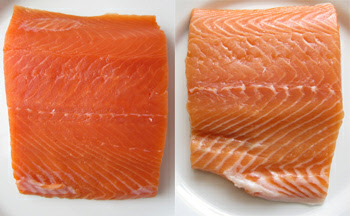
 The controversy about salmon consumption has been going on for over ten years. Although
salmon farming techniques allowed scaling up fish production to meet consumer demands
at very competitive sale prices, the quality differences between farmed salmon and
its wild counterpart is the subject of debates.
The controversy about salmon consumption has been going on for over ten years. Although
salmon farming techniques allowed scaling up fish production to meet consumer demands
at very competitive sale prices, the quality differences between farmed salmon and
its wild counterpart is the subject of debates.
You don't need sophisticated laboratory equipment to notice the sharp differences
between farmed and wild salmon. Wild salmon usually shows a beautiful dark-
The reason for this decrease in quality is in the farming process. Wild salmon usually
start their life in non-

The real cost of eating fish.
Experts’ recommendations for a healthy and sustainable seafood choice
The benefit of including fish in your diet goes beyond the vast number of delicious
recipes that can be prepared with it. Many nutrients which are found in fish oils,
can be obtained almost exclusively from fish sources. Omega-
Seafood, however, comes at an additional price than what you pay for it at the supermarket.
Fish and seafood in general act as a seawater filter, retaining many chemicals released
into the ocean from human pollution or natural sources. Mercury and other chemicals
eventually reach our bodies at the kitchen table or the sushi restaurant, exposing
ourselves to long-

A fillet of wild sockeye salmon is compared with wild salmon
To make matters worse, some wild-
Putting fish on the dining table therefore becomes a compromise between our culinary tastes, nutritional needs, and health risks in addition to environmental impact.
Salmon, canned tuna and shrimp are the most abundantly consumed fish products in North America. Consumption of salmon in the US has more than doubled in the fifteen years between 1989 and 2004, reaching the astonishing amount of 300,000 metric tons per year. The environmental consequences for some salmon populations have been disastrous. The population of North Atlantic salmon for example, known as Salmon salar, has been reduced almost to extinction.
Your diet customized with one click!
One
Click
Diet
One
Click
Diet

Copyright © 2010 OneClickDiet.com All right reserved.
No part of this web-
Disclaimer: The information provided on this site is for informational purposes only and is not a substitute for medical or nutritional advice, or treatment for any medical conditions. You should consult a healthcare professional or nutritionist before starting any diet, exercise or supplementation program, or if you have or suspect you might have a health problem. Actual results from nutritional plans and diets as well as exercise activities usually vary among individuals. The products and the claims made about specific products on or through this site have not been evaluated by the United States Food and Drug Administration (US F.D.A.) and are not intended to diagnose, treat, cure or prevent any disease. You should not use the information on this site for diagnosis or treatment of any health problem or for prescription of any medication or other treatment. Please view our full "Terms Of Use" for more information and the terms and conditions governing your use of this site.
Home
About
Contact us
